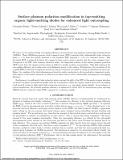Files in this item
Surface plasmon polariton modification in top-emitting organic light-emitting diodes for enhanced light outcoupling
Item metadata
| dc.contributor.author | Fuchs, C. | |
| dc.contributor.author | Schwab, T. | |
| dc.contributor.author | Wieczorek, M. | |
| dc.contributor.author | Gather, M.C. | |
| dc.contributor.author | Hofmann, S. | |
| dc.contributor.author | Leo, K. | |
| dc.contributor.author | Scholz, R. | |
| dc.contributor.editor | So, F. | |
| dc.date.accessioned | 2015-03-03T12:01:02Z | |
| dc.date.available | 2015-03-03T12:01:02Z | |
| dc.date.issued | 2014 | |
| dc.identifier | 172276634 | |
| dc.identifier | bb278344-8ed1-4124-b8a0-e7b257fdbd8e | |
| dc.identifier | 84922765275 | |
| dc.identifier.citation | Fuchs , C , Schwab , T , Wieczorek , M , Gather , M C , Hofmann , S , Leo , K & Scholz , R 2014 , Surface plasmon polariton modification in top-emitting organic light-emitting diodes for enhanced light outcoupling . in F So (ed.) , Organic Light Emitting Materials and Devices XVIII . vol. 9183 , Proceedings of SPIE , vol. 9183 , SPIE , Organic Light Emitting Materials and Devices XVIII , San Diego , United Kingdom , 17/08/14 . https://doi.org/10.1117/12.2061585 | en |
| dc.identifier.citation | conference | en |
| dc.identifier.isbn | 9781628412109 | |
| dc.identifier.issn | 0277-786X | |
| dc.identifier.other | ORCID: /0000-0002-4857-5562/work/47136460 | |
| dc.identifier.uri | https://hdl.handle.net/10023/6158 | |
| dc.description.abstract | We report on the enhanced light outcoupling efficiency of monochrome top-emitting organic light-emitting diodes (OLEDs). These OLEDs incorporate a hole transport layer (HTL) material with a substantially lower refractive index (∼ 1:5) than the emitter material or the standard HTL material (∼ 1:8) of a reference device. This low-index HTL is situated between the opaque bottom metal contact (anode) and the active emission layer. Compared to an HTL with common refractive index, the dispersion relation of the surface plasmon polariton (SPP) mode from the opaque metal contact is shifted to smaller in-plane wavenumbers. This shift enhances the outcoupling efficiency as it reduces the total dissipated power of the emitter. Furthermore, the excitation of the coupled SPPs at the thin transparent metal top contact (cathode) is avoided by using an ultrathin top electrode. Hence, the coupling of the electroluminescence from the emitter molecules to all non-radiative evanescent modes, with respect to the emitter material, is reduced by at least a factor of two, additionally increasing the outcoupling efficiency. Furthermore, for sufficiently high refractive index contrast the shift of the SPP at the anode/organic interface can lead to in-plane wavenumbers smaller than the wavenumber within the organic emitter layer and outcoupling of all excited modes by high index light extraction structures, e.g. microlens, seems feasible. In accordance to optical simulations, the external quantum efficiency is enhanced by about 20% for monochrome green emitting OLEDs with low refractive index HTL compared to a reference sample. | |
| dc.format.extent | 893456 | |
| dc.language.iso | eng | |
| dc.publisher | SPIE | |
| dc.relation.ispartof | Organic Light Emitting Materials and Devices XVIII | en |
| dc.relation.ispartofseries | Proceedings of SPIE | en |
| dc.rights | Fuchs, C., Schwab, T., Wieczorek, M., Gather, M. C., Hofmann, S., Leo, K., & Scholz, R. "Surface plasmon polariton modification in top-emitting organic light-emitting diodes for enhanced light outcoupling." In So, F. (Ed.), Organic Light Emitting Materials and Devices XVIII. (Proceedings of SPIE), 9183 (2014). Copyright 2014 Society of Photo Optical Instrumentation Engineers. One print or electronic copy may be made for personal use only. Systematic reproduction and distribution, duplication of any material in this paper for a fee or for commercial purposes, or modification of the content of the paper are prohibited. | en |
| dc.subject | QC Physics | en |
| dc.subject.lcc | QC | en |
| dc.title | Surface plasmon polariton modification in top-emitting organic light-emitting diodes for enhanced light outcoupling | en |
| dc.type | Conference item | en |
| dc.contributor.institution | University of St Andrews.School of Physics and Astronomy | en |
| dc.contributor.institution | University of St Andrews.Biomedical Sciences Research Complex | en |
| dc.identifier.doi | 10.1117/12.2061585 |
This item appears in the following Collection(s)
Items in the St Andrews Research Repository are protected by copyright, with all rights reserved, unless otherwise indicated.

